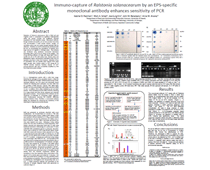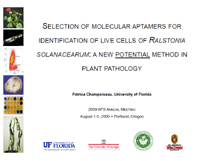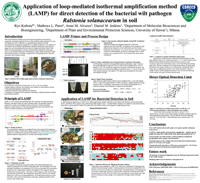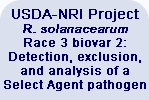| USDA-NRI Research Program | |||
| Accomplishments for Aim 1 Develop rapid, robust, and reliable diagnostic assays for Ralstonia solanacearum race 3 biovar 2, using both immunological and DNA-based approaches Click here to see accomplishments for Aim2 |
|
| This page contains files in PDF format. To read these files you must have Adobe Reader installed on your computer (free). | |
|
- Use of molecular beacons for direct detection of Loop-mediated isothermal AMPlification (LAMP) amplicons of the plant pathogen Ralstonia solanacearum (Meeting oral communication 2009). Isothermal DNA amplification techniques, such as Loop-mediated isothermal AMPlification (LAMP), are suitable for rapid detection of bacteria with simple field devices due to the ability to amplify DNA with high specificity, efficiency, and speed without thermal cycling. However, an additional step to visualize the product helps confirm the presence of the amplicons and ensure specificity of the reaction. Molecular beacons...<Read more> - Immuno-capture of Ralstonia solanacearum by an EPS-specific monoclonal antibody enhances sensitivity of PCR. (Meeting poster 2009). Detection of Ralstonia solanacearum (Rs) in field soil and irrigation water is complicated by significant heterogeneity within the species complex and insufficient bacterial populations for most detection assays. DNA-based methods, though sensitive and specific, are not very practical since it only accommodates a small sample volume...<Read more> - Selection of molecular aptamers for identification of live cells of Ralstonia solanacearum: A new method in plant pathology. (Meeting oral communication 2009). Ralstonia solanacearum (Rs) has the potential to be one of the most damaging plant pathogenic bacteria in production fields of diverse crops. One subgroup of Rs, designated race 3 biovar 2 (R3bv2), is on the select agent list and is subject to the strictest biosecurity regulations in the United States. Due to its status, the need for unambiguous identification of R3bv2 is critical...<Read more> - Detection of Ralstonia solanacearum by loop-mediated isothermal amplification (Journal article 2008). Here we report a rapid and sensitive detection of R. solanacearum using an isothermal method for copying DNA known as loop-mediated amplification (LAMP). The technique may be useful for developing rapid and sensitive detection methods for the R. solanacearum pathogen in soil and water...<Read more> - Application of loop-mediated isothermal amplification method (LAMP) for detection of the bacterial wilt pathogen Ralstonia solanacearum in environmental samples (Meeting poster 2008). The objective of this research was to develop a rapid detection method for Ralstonia solanacearum (Rs) in environmental samples, based on Isothermal DNA amplification techniques, such as Loop-mediated isothermal AMPlification (LAMP)...<Read more> |
||
- Kubota R, Peckham GD, Alvarez AM, Jenkins DM. 2009. Use of molecular beacons for direct detection of Loop-mediated isothermal AMPlification (LAMP) amplicons of the plant pathogen Ralstonia solanacearum. Phytopathology 99 (6): S68-S68 Suppl.
Abstract. Isothermal DNA amplification techniques, such as Loop-mediated isothermal AMPlification (LAMP), are suitable for rapid detection of bacteria with simple field devices due to the ability to amplify DNA with high specificity, efficiency, and speed without thermal cycling. However, an additional step to visualize the product helps confirm the presence of the amplicons and ensure specificity of the reaction. Molecular beacons were designed to detect specific LAMP amplicons that distinguished several unique populations of the bacterial wilt pathogen Ralstonia solanacearum (Rs). Sequence-specific molecular beacons were designed to target loop regions, which are unique single-stranded DNA sequences generated by the LAMP primer sets. The reaction of the molecular beacon with the loop region distinguished group-specific amplicons generated by LAMP primer sets from a variety of closely related Rs strains. Group-specific LAMP was evaluated against 274 strains of Rs representing three phylotypes, four races and four biovars. Rs-specific LAMP products were detected in samples containing target strains but not in samples containing other Rs strains or non-target species. Early prototypes suggest that the LAMP reaction coupled with DNA hybridization probes can form the basis of a simple rapid diagnostic system for subgroups of R. solanacearum. Contact author: Ryo Kubota <peckham@hawaii.edu> |
||
- Peckham GD, Schell MA, Kim J, Berestecky JM, Alvarez AM. 2009. Immuno-capture of Ralstonia solanacearum by an EPS-specific monoclonal antibody enhances sensitivity of PCR. Phytopathology 99 (6): S101-S101 Suppl.
Abstract. Detection of Ralstonia solanacearum (Rs) in field soil and irrigation water is complicated by significant heterogeneity within the species complex and insufficient bacterial populations for most detection assays. DNA-based methods, though sensitive and specific, are not very practical since it only accommodates a small sample volume, usually 1–5 microliters, which may not contain enough bacterial DNA for detection. Therefore, an anti-Rs antibody was developed with the aim of concentrating dilute populations of bacteria from large volumes of irrigation or drainage water. The antibody was developed using traditional monoclonal hybridoma technology with a pool of 10 Rs strains as the antigen. The strong reacting antibody 3.H7 (IgG3 with kappa light chain) is specific for all Rs EPS (109 strains from diverse hosts and geographical origins, representing 3 phylotypes) with only one exception (one BDB strain from banana). Detection of dilute concentrations of Rs was not possible when aliquots of large water samples were directly added to PCR reactions (using fliC or 759/760 primers); however, aliquots of 3.H7-immuno-captured cells were successfully amplified by PCR from these same water samples. Contact author: Gabriel D. Peckham <peckham@hawaii.edu> |
||
- Champoiseau PG, Jones JB, Sefah K, and Tan W. 2009. Selection of molecular aptamers for identification of live cells of Ralstonia solanacearum: A new method in plant pathology. Phytopathology 99 (6): S20-S20 Suppl.
Abstract. Ralstonia solanacearum (Rs) has the potential to be one of the most damaging plant pathogenic bacteria in production fields of diverse crops. One subgroup of Rs, designated race 3 biovar 2 (R3bv2), is on the select agent list and is subject to the strictest biosecurity regulations in the United States. Due to its status, the need for unambiguous identification of R3bv2 is critical; however, diagnostic tools currently used by official laboratories lack the requisite sensitivity, specificity, or speed. Molecular aptamers are single-stranded oligonucleotides that can specifically bind with high affinity to a variety of molecules ranging from macromolecules to small compounds. They are generated through an in vitro selection process termed SELEX (system evolution of ligands by exponential enrichment) and have been used quasi-exclusively in human cancer research. Recently, a cell-SELEX protocol was developed to successfully produce aptamers that could specifically differentiate two closely-related cell lines using whole live cells. In this study, we used Rs race 3 strain UW485 (target cells) and race 1 strain Rs5 (control cells) to evaluate the potential for cell-SELEX to produce Rs race 3-specific aptamers. After 16 rounds of selection, flow-cytometry data indicated enrichment of aptamers specific to the UW485 strain, with evidence for targeting cell exopolysaccharides. Aptamers potentially could be produced and used in the future as reproducible, fast and highly-specific diagnostic tools for R3bv2. Contact author: Patrice G. Champoiseau <pchampoiseau@ufl.edu> |
||
|
- Kubota R, Vine BG, Alvarez AM, Jenkins, DM. 2008. Detection of Ralstonia solanacearum by loop-mediated isothermal amplification. Phytopathology 98:1045-1051. Abstract. Ralstonia solanacearum is a pathogenic bacterium that causes wilt in over 200 plant species. Here we report a rapid and sensitive detection of R. solanacearum using an isothermal method for copying DNA known as loop-mediated amplification (LAMP). A set of four primers was designed to replicate the gene coding for the flagellar subunit, fliC, and conditions for detection were optimized to complete in 60 min at 65 degrees C. Magnesium pyrophosphate resulting from the amplification reaction could be detected optically as an increase in the solution turbidity, and the DNA products spread in a reproducible ladder-like banding pattern after electrophoresis in an agarose gel. Replication of the fliC gene was detected only from R. solanacearum. The detection limit of this LAMP assay was between 104 to 106 colony forming units/ml, and the technique may be useful for developing rapid and sensitive detection methods for the R. solanacearum pathogen in soil and water. Contact author: Daniel M. Jenkins <danielje@hawaii.edu> |
||
Kubota R, Paret ML, Alvarez AM, and Jenkins DM. 2008. Application of loop-mediated isothermal amplification method (LAMP) for detection of the bacterial wilt pathogen Ralstonia solanacearum in environmental samples. Phytopathology 98 (6): S85-S85 Suppl.
Abstract: DNA-based detection methods can provide improved specificity and sensitivity compared to serological methods. However, these methods remain impractical for most field applications due to difficulties in concentrating the organism from the environmental samples and ensuring that enough DNA is available for detection. Isothermal DNA amplification techniques, such as Loop-mediated isothermal AMPlification (LAMP), might be suitable for rapid field detection because of its ability to amplify DNA with high specificity, efficiency, and speed without thermal cyclers. The objective of this research was to develop a rapid detection method for Ralstonia solanacearum (Rs) in environmental samples. To demonstrate the application of LAMP in environmental samples, edible ginger plants (Zingiber officinale) were infected with Rs, and effluent water samples were collected from daily irrigation water. A simple filtration technique was applied to concentrate bacteria, followed by a species-specific LAMP and pathogen presence was visually determined as the precipitation of an insoluble pyrophosphate by-product of amplification, which increased the turbidity of the solution. The detection limit of the direct LAMP assay was between 10(^3) - 10(^5) CFU/ml, which is the same as PCR and more sensitive than ELISA. LAMP shows promise for not only rapid detection but also for discrimination of closely related sub population of Rs in soil and water. Contact author: Daniel M. Jenkins <danielje@hawaii.edu> |
||
| Click here to see project summary - project team & collaborators - project timeline. |





